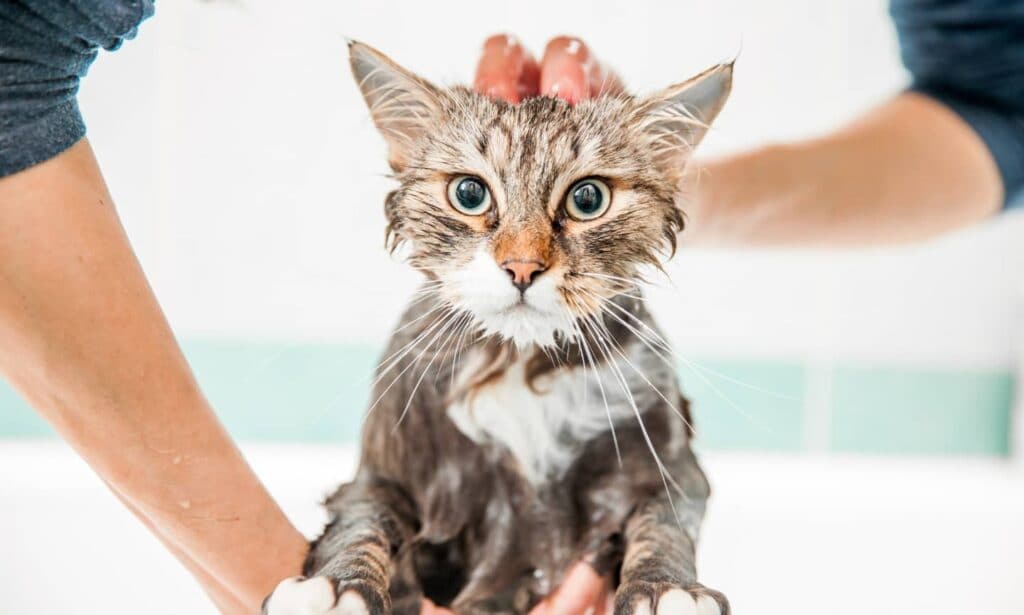Picture this: Your kitty has rolled in something sticky or stinky and needs a bath ASAP—but the groomer can’t get you in right away. What do you do? Bathe your cat at home, of course.
I know what you’re thinking: “Um, have you met my cat? They’re going to freak out!” But as a professional groomer, I’m here to tell you that you don’t need a pro to wash something gross or unhealthy off your cat. You just need the right supplies, extra-calm nerves and clear instructions. So take a deep breath, follow these step-by-step instructions for how to bathe a cat, and you’ll have a clean kitty in no time.
Click the buttons below to jump to each section:
Do Cats Need Baths?
Cats are typically self-cleaning creatures, and many kitties can go their whole lives without needing a cat bath. But some cats require them, either on an occasional or regular basis. Here are a few instances where you may need to know how to give a cat a bath:
- You have a hairless breed. Hairless cats need regular baths to remove excess oil from their skin.
- You have a long-haired cat. Even if you keep your cat well-brushed, they might struggle to keep themselves clean. That’s where you come in.
- Your cat can’t clean themselves thoroughly because they are obese, arthritic or elderly.
- Your cat gets fleas, lice or another parasite. You may need to bathe your cat with a special shampoo to get rid of the bugs.
- Your cat gets into something. Cats tend to get into sticky situations—sometimes literally! If your cat is sticky, smelly, oily, greasy, grimy or otherwise dirty, they’ll need your help to get clean.
It should go without saying, but I’ll say it anyway: If your cat dislikes water, only bathe them if you absolutely have to. It’ll save stress for both you and your kitty.
Where to Bathe Your Cat
Unlike dogs, cats shouldn’t be bathed outside—who knows where they’ll run off to if they slip out of your hands. Opt for an indoor location, preferably someplace contained. Commonly used locations for cat baths include:
- Bathroom sink. The benefit of the bathroom sink is that you can close the door, giving your kitty fewer places to hide if they escape.
- Kitchen sink. Usually bigger than the bathroom sink, the kitchen sink is another good place to bathe your cat. Just make sure to cover the drain if you have a garbage disposal.
- Bathtub. If you have a handheld shower sprayer, washing your feline in the tub may make things easier.
Supplies You’ll Need to Bathe Your Cat
Make sure you have all your cat-washing supplies ready before you start. One of the main things you’ll need is cat shampoo—but before you lather up your kitty, keep these tips in mind:
- Choose a shampoo specifically for cats. Not all dog shampoo is safe for cats, so read labels carefully to make sure the shampoo is formulated for cats, too.
- Follow the directions on the label. Some shampoos need to be diluted before being used on pets. Failing to do so can irritate your cat’s skin, so always read the label and follow the instructions.
You’ll also need these items:
- Cat-safe ear cleaner
- Treats
- A bathmat, towel or another non-skid surface for the bottom of the tub or sink
- A spraying faucet attachment like Rinse Ace 3-Way Faucet Sprayer, or a water pitcher for rinsing your cat
- Grooming wipes made for wiping the eyes and face, like Optixcare Eye Cleaning Wipes
- Plenty of towels
- Cotton balls
- Conditioner (optional)
- A pet grooming loop such as Coastal Pet Products Adjustable Nylon Grooming Loop (optional)
- A pet dryer like the Flying Pig Grooming High Velocity Dryer (optional)
- An extra pair of hands (optional, but EXTREMELY useful!)
Tips for Keeping Your Cat Calm
Keeping your kitty relaxed and happy will make the bath easier for both of you. Here are some tips for keeping your cat calm:
- Use a Feliway diffuser, which uses pheromones to help your cat feel safe and secure.
- Keep yourself calm. If you’re stressed, your cat will feel it and could react with stress behaviors of their own. So practice deep breathing, put on some relaxing music—anything to keep your own anxiety down.
- Place a mat or wet towel in the bottom of the sink or tub. That will give your cat secure footing so they can check “slipping and falling” off their “to-worry-about” list.
- Make sure the water isn’t too hot or cold. Cats’ skin is especially sensitive, so keep the water lukewarm to ensure that they’re comfortable.
- Offer plenty of treats, both during and after the bath. Your cat’s more likely to stay calm if there’s a tasty treat in store for them.

Preparing for Your Cat’s Bath
Set yourself up for success by following these tips before you bathe your cat.
- Cut your cat’s nails: Long, sharp nails will hurt more if your cat scratches you, so trim their nails first. You can do this the day before, so your kitty isn’t already stressed when you start washing them. Find out how to trim your cat’s nails.
- Brush and comb your kitty: Some people wash their cats when they have mats, thinking the bath will make the knots easier to brush out. In fact, the opposite is true. Water makes mats worse, so make sure your kitty is brushed and dematted before the bath. Again, you can do this the day before.
- Brush your kitty’s teeth: Did you know more than half of cats over age 3 have some form of dental disease? Brushing your cat’s teeth is as important as brushing your own—but it can be a bit messier. Brush your kitty’s teeth before the bath so you can clean up leftover toothpaste residue. Here’s how to do it.
- Get everything ready: You don’t want to have a wet cat in your hands when you realize you’ve forgotten something. Make sure your supplies are handy before fetching your cat.
- Tire your cat with playtime: A tired cat will be less motivated to escape during the bath, so wear your kitty out with a teaser or another favorite toy. When they’re too tired to play anymore, it’s time for the bath.
How to Hold Your Cat
It’s just a fact of life: Some cats really, really dislike water. Many cats can learn to appreciate the benefits of a bath over time, but if your kitty is new to bathtime, they may try to get away by any means necessary. For that reason, I suggest using a grooming loop.
Grooming loops are essentially tethers that wrap around your pet and attach to something stable in your home. For your cat’s bath, I recommend tethering their loop to the faucet of your sink or bathtub.
When it comes to grooming loops and cats, placement is everything. Do not put the grooming loop around your cat’s neck. Your cat could strangle themselves or incur other serious injuries if they try to escape with a loop around their neck. Instead, position the grooming loop over one shoulder and under the opposite armpit, so it wraps diagonally across their chest like the shoulder strap of a seat belt.
Again, the grooming loop is NOT a collar—do not put it around your cat’s neck.
How to Bathe a Cat, Step-by-Step
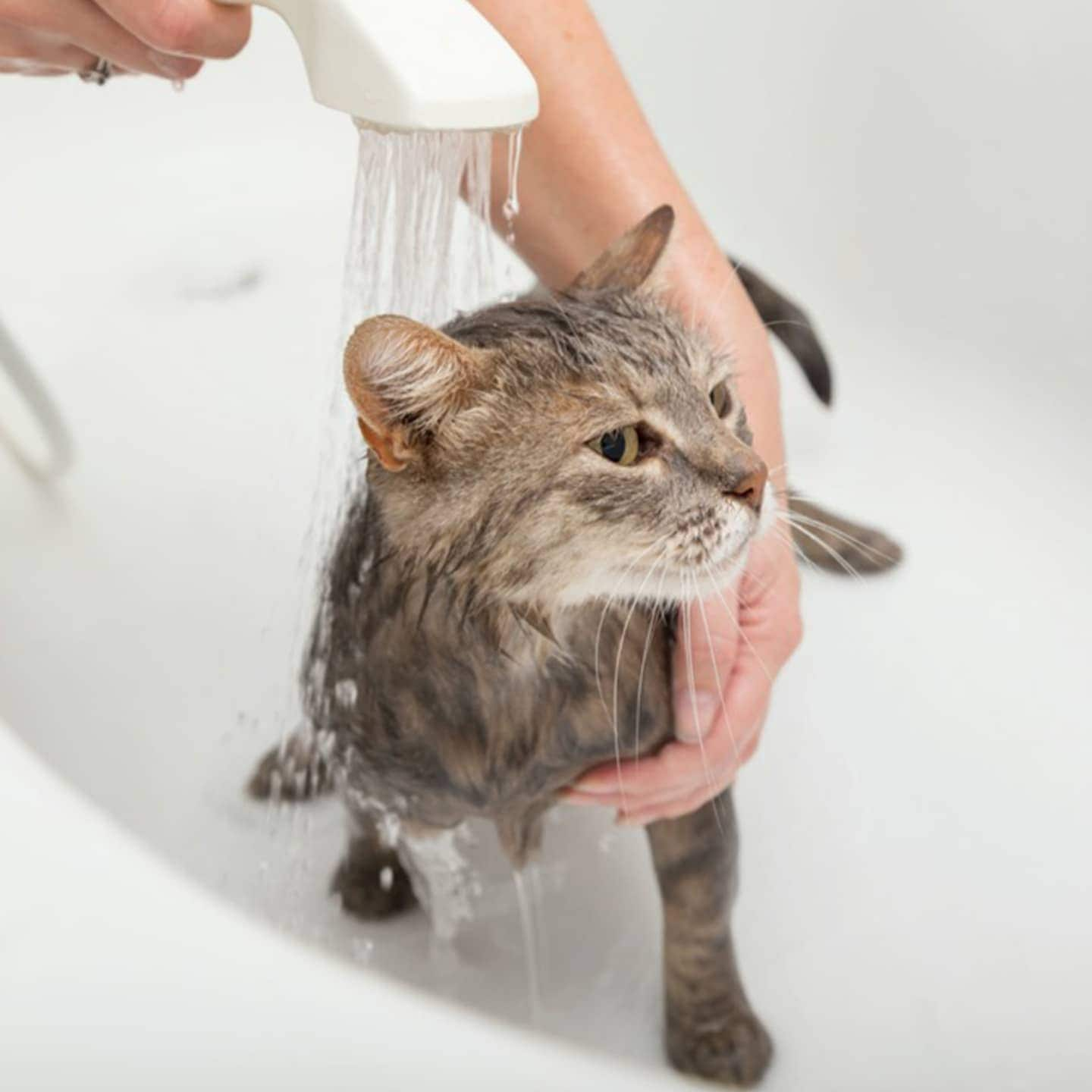
1 Wet Your Cat from the Ears Back
Using a sprayer or pitcher, wet your kitty from behind their ears to their tail. You can use a sprayer, a cup or even your cupped hand to wet their underside. If necessary, carefully use one hand under their front legs to lift them up to wet the underside.
Try to avoid getting your cat’s head wet, especially around the ears. Nobody likes getting water in their ears, cats included, and excess moisture in your cat’s ears could cause an infection. If your cat will tolerate it, put half a cotton ball in each ear to keep water out of the ear canals.
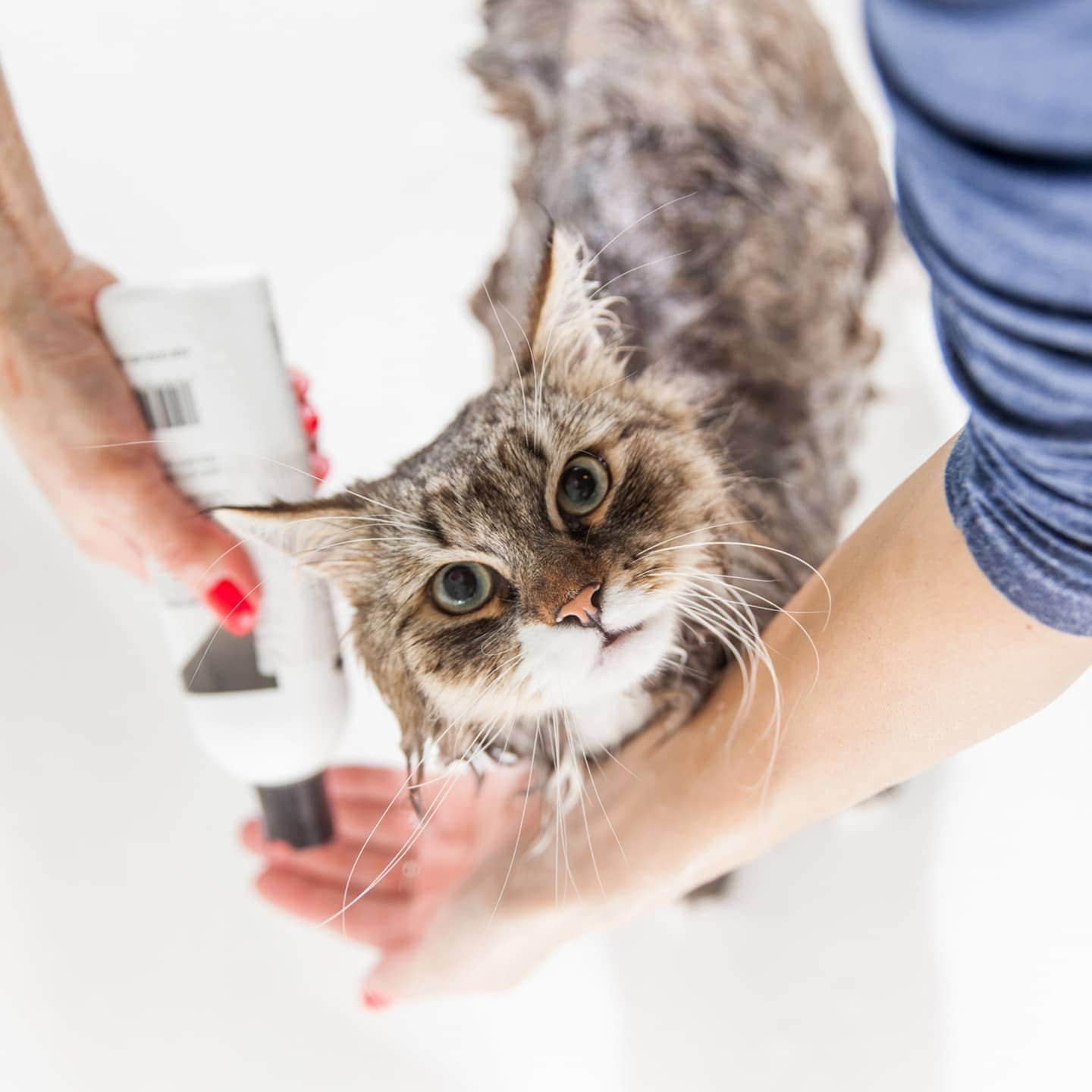
2 Apply Shampoo and Lather
Following the directions on the shampoo bottle, lather your kitty from the neck down, paying particular attention to their genitals and “armpits.” Make sure not to get any shampoo in your kitty’s eyes. If you have help, one person can control the cat while the other scrubs.
Remember to read the shampoo label carefully and follow any instructions. Some shampoos need to be diluted before use.
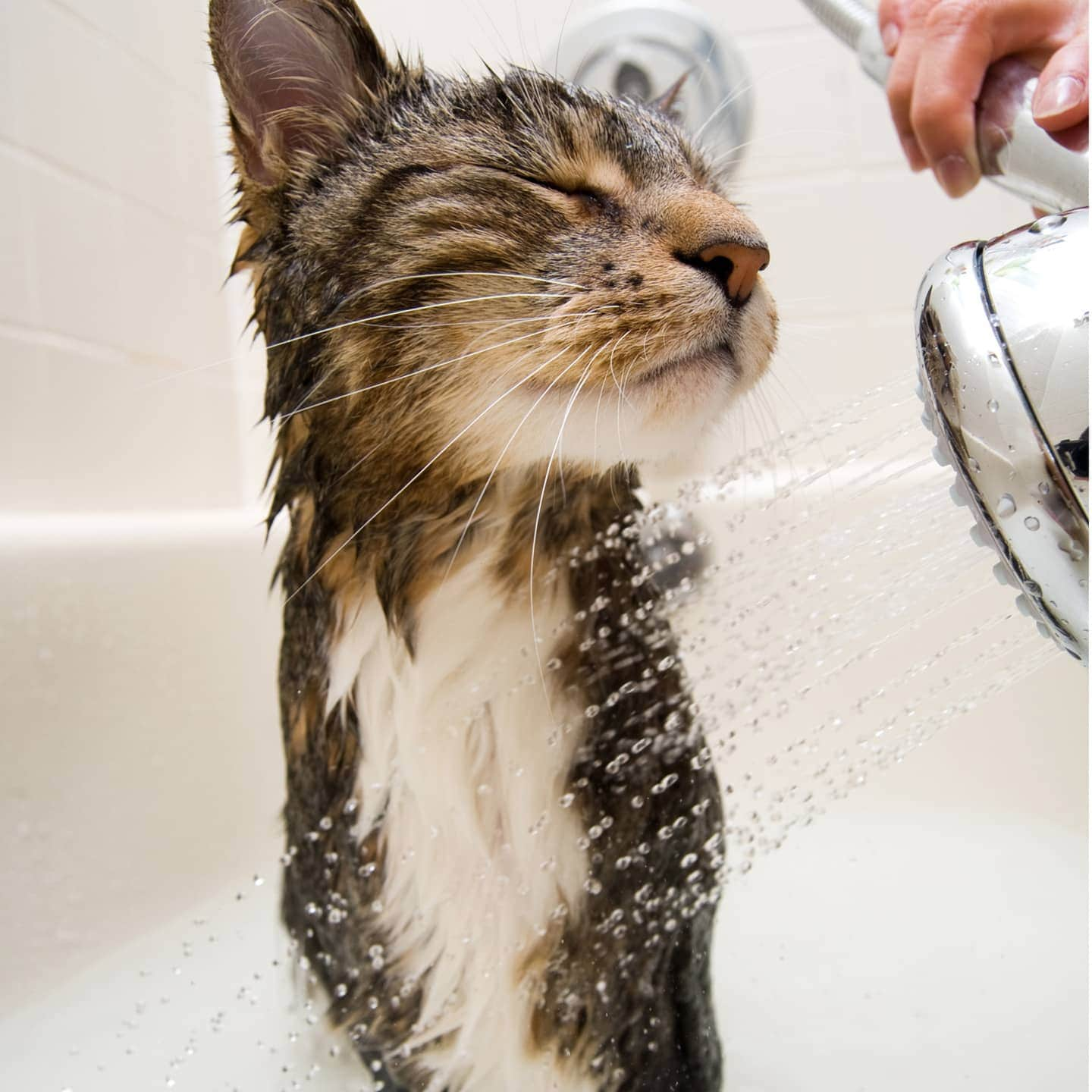
3 Rinse, Rinse, Rinse
Shampoo residue can irritate your kitty’s skin, so you’ll want to ensure it’s all washed away. When you think you have thoroughly rinsed your cat, check every nook and cranny, then rinse again.
For cats with long hair or dry skin, you may want to apply a cat-safe conditioner after you rinse the shampoo out. Just make sure you rinse really well afterward like you did with the shampoo.
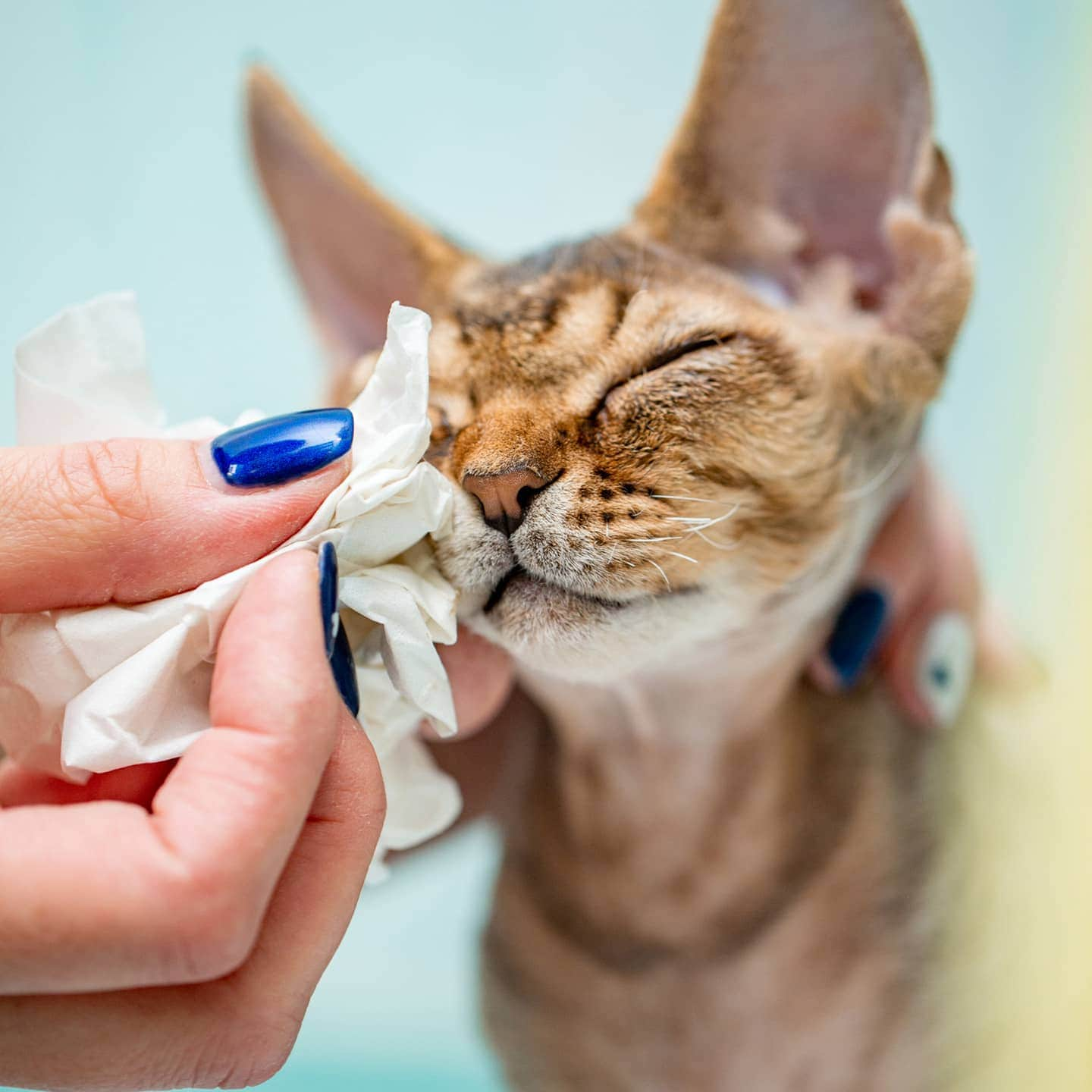
4 Wipe Your Cat’s Face and Clean Their Ears
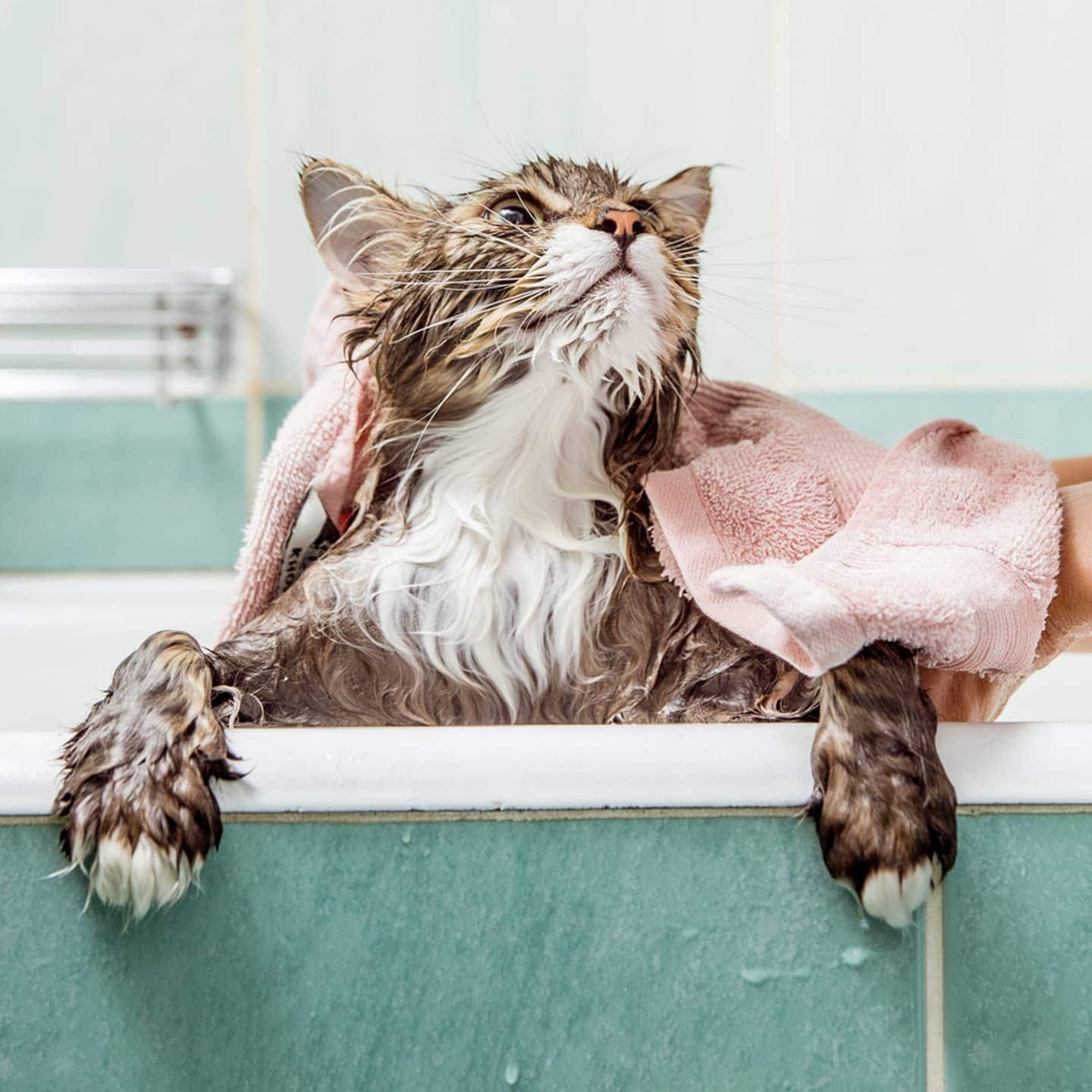
5 Dry Your Cat
Dry your cat as well as you can using at least 1-2 towels. If your cat will tolerate it, you may want to try using a dryer on a low, cool setting—but note that the sound could scare your kitty.
Remember: When using a dryer, you shouldn’t use any heat settings.
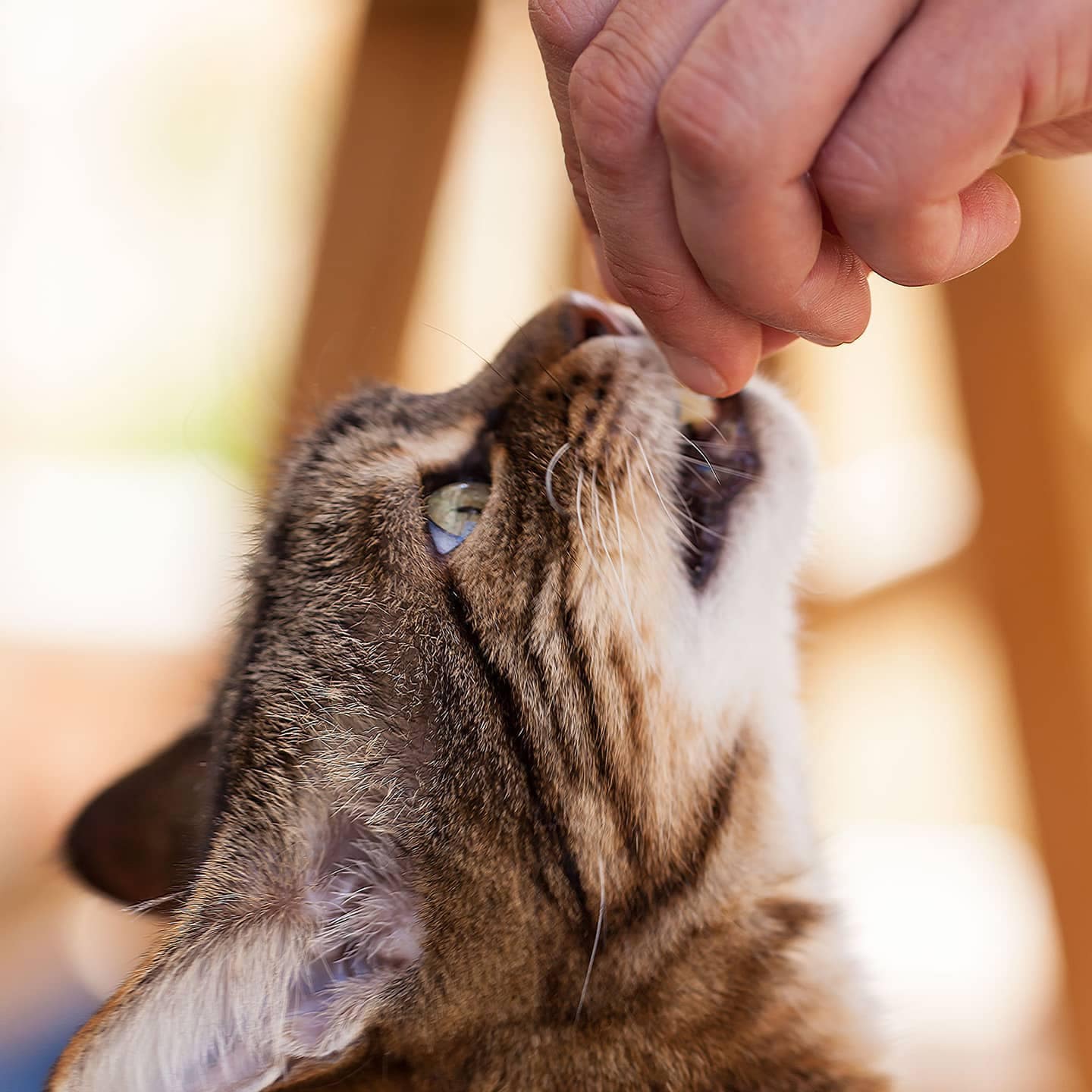
6Reward Your Kitty Handsomely
Once you’ve finished, give your cat plenty of treats, playtime, snuggles or whatever their favorite thing is.
Hey, they deserve it! Plus, treating your cat at the end of the bath helps to end the experience on a positive note—and maybe, just maybe, it'll help them look forward to the next time they need a bath.
How Often Should You Bathe a Cat?
Remember: Most cats only need baths when they get dirty or stinky, and many can go their whole lives without being bathed. But there are a few types of cats who need regular baths:
- Hairless cats need baths every week or so to help keep their skin moisturized and not overly oily.
- Long-haired cats or cats who can’t groom themselves may need a bath every month or two.
Washing a cat too frequently can dry out their skin, so stick with gentle shampoos and conditioners if you wash your feline more than once or twice a month.
Share:
